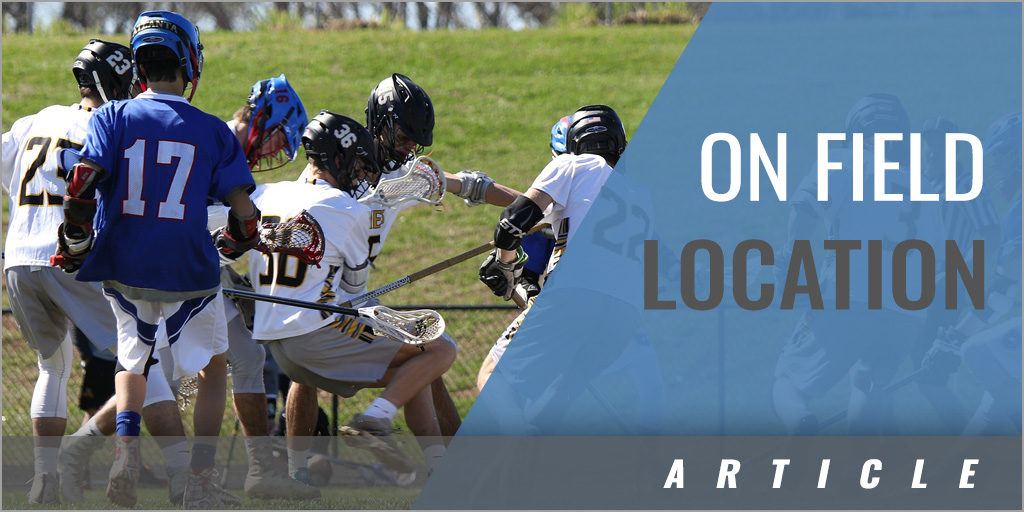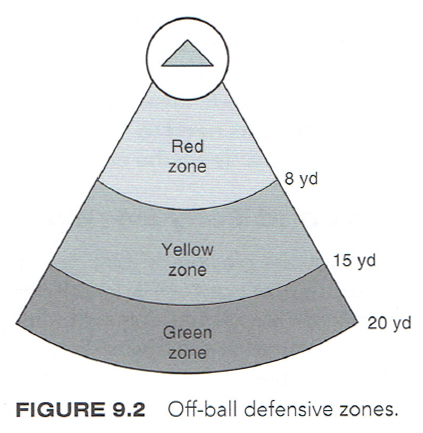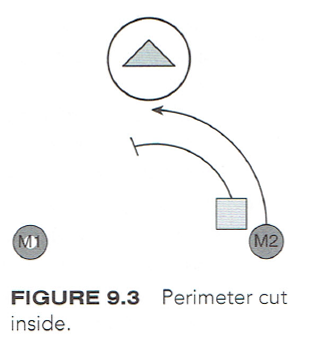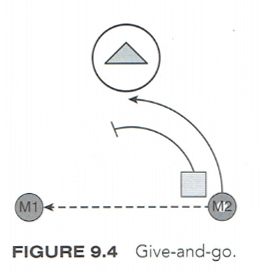|
By: Don Zimmerman and Peter England Originally Published in: Men's Lacrosse Provided by: Human Kinetics When playing off-ball defense, a general rule is that the closer your man is to the goal, the more of a threat he is to receive a pass - and the more you have to focus on him (compared to focusing on the ball). You adjust to where your man is located on the field in relation to the goal. The fundamentals include vision or focus (man versus ball), body position (square versus opened up), and cushion (tight or loose). Your mental and physical focus changes depending on where your man is located in relation to the goal and to the ball. Your vision, body position, and cushion will changed based on where your opponent is on the field. The area of the field in front of the goal is a place of keen defensive interest. Off-ball defenders have to balance watching their man and watching the ball base on their man's distance from the goal. This area can be broken up into three zones (see figure 9.2), and each zone has specific rules for off-ball defenders to apply.
In addition, off-ball defense is about adjusting to the movement of your man and the movement of the ball. Your man will move along the perimeter, from the perimeter to the inside, and from the inside back to the perimeter. Here are some rules to follow based on whether your man is on the perimeter or on the inside:
Let's look at a few scenarios to illustrate these concepts. The first scenario explains how an off-ball defender will adjust his approach based on the movement of his man from the perimeter to the inside. The second scenario explains adjustments on movement from the perimeter to the inside with a give-and-go. The third scenario explains adjustments on movement from the perimeter to the inside and then back to the perimeter. Scenario 1 Midfielder 1 has the ball out top; midfielder 2 is on the perimeter with his defender. If midfielder 2 takes his defender to the crease (cuts inside), the defender must turn and adjust his position so that when he is inside and the ball is out front, he is now playing topside with no cushion. If the defender doesn't adjust his position and continues to play between midfielder 2 and the goal, midfielder 2 can cut back for the ball and shoot (see figure 9.3). Scenario 2
Midfielder 1 is out top; midfielder 2 has the ball out top with his defender. Midfielder 2 throws the ball to midfielder 1 on the perimeter and cuts down for the ball (give-and-go). The defender uses proper give-and-go defense by opening up to the ball and his man. As midfielder 2 starts to cut, the defender plays between his man and the goal, shading to the ball side. As midfielder 2 gets closer inside, the defender needs to adjust to a topside position with no cushion because midfielder 2 can pop out from the crease to get the ball (see figure 9.4). Scenario 3
The attackman has the ball behind the goal at position 2. The midfielder is at position 3 on the perimeter with his defender. The defender drops his midfielder and gives him cushion. The defender is playing between his man and the goal (man-goal position), giving the midfielder a lot of cushion. The midfielder cuts directly toward the attackman. If the defender plays man-gaol, the midfielder has a clearer path to the feed. If the defender plays man-goal, but "shades" more to the ball side, then the midfielder has to arc away from the feed. If the midfielder is not open for a feed, he will go back out top to the perimeter. The defender recovers out top, giving the midfielder more cushion, and changers from playing ball side to playing the man-goal perimeter position. The following drill will help players learn the proper technique for making adjustments on defense (see figure 9.5). |











